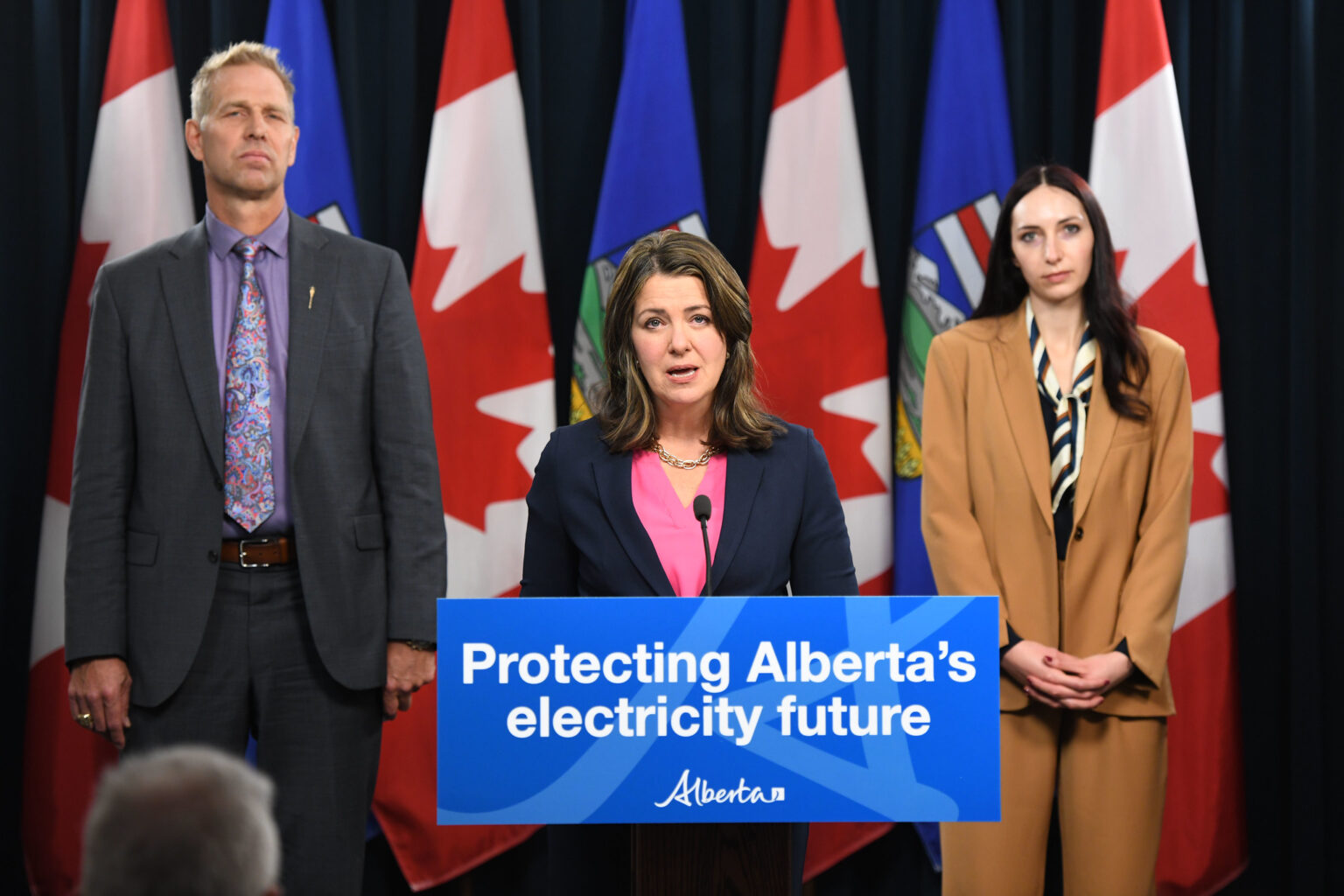As Alberta’s moratorium on renewable energy development comes to an end, Premier Danielle Smith has announced a new set of regulations critics argue will handicap the province’s economy.
The province has outlined 13 new regulations limiting wind and solar projects near agriculture land and other proposed “protected” areas. These include the creation of 35-kilometre buffer zones intended to protect what the province has termed “pristine viewscapes” from wind power development. The new rules followed a seven month moratorium that halted development of more than 100 wind and solar projects in the province, worth an estimated $33 billion.
Smith’s new regulations have been widely condemned for creating unnecessary uncertainty, and undermining a fast-growing, multi-billion dollar renewable energy sector that provided direct financial stimulus to rural communities. According to the CBC, 92 percent of all new renewable energy generation and capacity built in Canada in 2023 took place in Alberta.
Jorden Dye, director of Business Renewables Centre Canada, called Smith’s new announcement a “soft moratorium” that has already harmed the industry. BRC-Canada has estimated that between 2019 and the end of 2023, renewable energy projects in Alberta created more than 6,000 jobs, involved a capital investment of $6.3 billion, and produced enough energy to power 1.7 million homes.
“By introducing three new regulatory frameworks without details, investors and developers are left wondering what this actually means for their projects,” Dye said in a statement. “Investors required certainty, and the government offered confusion.”
Nagwan Al-Guneid, Alberta NDP’s energy and climate critic, released a statement immediately following Smith’s announcement calling the moratorium and new rules anti-business. Al-Guneid called on the premier to release documents revealing how the government developed its renewable energy policies.
Why the moratorium was instituted in the first place remains unclear. As previously reported in The Narwhal, though the Smith government insisted they were responding to concerns from landowners, municipalities, the grid operator and the provincial regulator, heavily redacted documents obtained through a freedom of information request indicate that Smith was already discussing a planned moratorium within a month of the spring 2023 provincial election, well before the time she previously indicated receiving letters of concern. To date, there is no clear explanation for why the government instituted the moratorium.
DeSmog recently reported that an anti-renewable energy group called Wind Concerns — which has denied climate change and calls carbon dioxide the “gas of life” — had a private meeting with premier Smith. Wind Concerns blames wind turbines for the deaths of birds and bats, has called the renewable energy source “grotesque,” and claims the global scientific consensus on the cause of climate change is misinformation.
Stephen Legault, Senior Manager, Alberta Energy Transition with Environmental Defence, decried what he called the premier’s ideological opposition to renewable power.
In a prepared statement, Legault said the premier’s announcement “demonstrates a profound lack of foresight” and that Smith has failed to recognize that “global market forces have already shifted to favour clean, inexpensive renewable energy.”
“Placing restrictions on solar, wind, and geothermal power that don’t apply to climate change causing oil and gas development will put Alberta’s burgeoning renewable energy industry at risk, and cost Albertans more for their energy,” said Legault.
Prior to the imposition of Smith’s moratorium on renewables last August, Alberta led Canada in solar and wind power investment. Alberta is consistently ranked as one of the sunniest places in Canada, as well as having conditions favorable to profitable wind energy development. Through land taxes, these renewable energy projects proved profitable to rural communities: dozens received $28 million from wind and solar projects in 2022. According to BRC-Canada, this would rise to $227 million annually by 2028 if all currently planned projects are completed.
Not only are the new regulations expected to sap investment in what had been a rapidly growing sector and deny important new revenue streams to rural citizens and municipalities, by discouraging renewable investment, Danielle Smith has interfered with the free market. This will likely keep electricity costs artificially higher than what might otherwise be accomplished. According to Environmental Defence, wind and solar are the least expensive sources of energy available in Canada. Solar power costs have contracted by 90 percent in the last decade; wind power by 70 percent.
The new regulations propose to ban solar and wind projects on prime agricultural land, though BRC-Canada estimates the vast majority of solar and wind projects in the province are only built on low-grade agricultural land. Applicants will now have to prove solar or wind projects can coexist with livestock or crops, though this has in fact been known for some time. Unlike fossil fuel energy production — which tends to make the land around it unsuitable for any other purposes — renewable energy systems help decarbonize agriculture, provide an additional revenue stream for farmers and ranchers, and further help decarbonize electrical grids.
BRC-Canada’s Dye is also concerned about the vagueness of the viewscapes requirement.
“Taken at face value, an unprecedented 35-kilometre buffer zone around all protected areas would eliminate 76 percent of southern Alberta and would create a backdoor land ban. Any project that’s even close to a protected area, or what might be considered a protected area, can’t move forward until there’s certainty from the provincial government.”
The bulk of Alberta’s population lives in its southern half, which is also where the majority of new solar and wind power investment has occurred in recent years.
Smith’s new regulations are unique to the renewable energy sector — placing restrictions that do not apply to other industries or land uses. Landowners in Alberta legally cannot refuse oil and gas companies from exploring on their land, but according to the new regulations, could be prevented from developing solar or wind power systems.
It’s a situation Jason Wang, senior analyst at the Pembina Institute, calls patently unfair.
“Landowners in affected areas can no longer invite a renewable energy project on their land, maximizing their potential revenue, if their land falls under these new land restrictions,” said Wang in a statement.
“These restrictions will lead to fewer projects, slow the growth of clean and inexpensive electricity, and curtail an otherwise reliable and growing source of municipal tax revenue.”
According to Environmental Defence, the Alberta government’s moratorium and new regulations will likely make it impossible for Alberta — and Canada — to achieve Paris Agreement targets for carbon dioxide emissions reductions.
Subscribe to our newsletter
Stay up to date with DeSmog news and alerts






